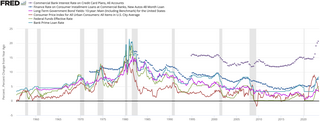Related Research Articles
Financial capital is any economic resource measured in terms of money used by entrepreneurs and businesses to buy what they need to make their products or to provide their services to the sector of the economy upon which their operation is based. In other words, financial capital is internal retained earnings generated by the entity or funds provided by lenders to businesses in order to purchase real capital equipment or services for producing new goods or services.
Financial instruments are monetary contracts between parties. They can be created, traded, modified and settled. They can be cash (currency), evidence of an ownership interest in an entity or a contractual right to receive or deliver in the form of currency (forex); debt ; equity (shares); or derivatives.

A lease is a contractual arrangement calling for the user to pay the owner for the use of an asset. Property, buildings and vehicles are common assets that are leased. Industrial or business equipment are also leased. Basically a lease agreement is a contract between two parties: the lessor and the lessee. The lessor is the legal owner of the asset, while the lessee obtains the right to use the asset in return for regular rental payments. The lessee also agrees to abide by various conditions regarding their use of the property or equipment. For example, a person leasing a car may agree to the condition that the car will only be used for personal use.

In accounting, "off-balance-sheet" (OBS), or incognito leverage, usually describes an asset, debt, or financing activity not on the company's balance sheet. Total return swaps are an example of an off-balance-sheet item.
Closed-end leasing is a contract-based system governed by law in the U.S. and Canada. It allows a person the use of property for a fixed term, and the right to buy that property for the agreed residual value when the term expires.
A leveraged lease or leased lender is a lease in which the lessor puts up some of the money required to purchase the asset and borrows the rest from a lender. The lender is given a senior secured interest on the asset and an assignment of the lease and lease payments. The lessee typically makes payments directly to the lender as the lease payments are assigned to the lender.

Accounting for leases in the United States is regulated by the Financial Accounting Standards Board (FASB) by the Financial Accounting Standards Number 13, now known as Accounting Standards Codification Topic 840. These standards were effective as of January 1, 1977. The FASB completed in February 2016 a revision of the lease accounting standard, referred to as ASC 842.
The expression "operating lease" is somewhat confusing as it has a different meaning based on the context that is under consideration. From a product characteristic standpoint, this type of a lease, as distinguished from a finance lease, is one where the lessor takes larger residual risk, whereas finance leases have no or a very low residual value position. As such, the operating lease is non full payout. From an accounting standpoint, this type of lease results in off balance sheet financing which can be advantageous for companies in terms of gearing and other accounting ratios.
A novated lease is a motor vehicle lease which has been novated, that is, the obligations in the contract have been transferred from one party to another.
Minimum lease payments are rental payments over the lease term including the amount of any bargain purchase option, premium, and any guaranteed residual value and excluding any rental relating to costs to be met by the lessor and any contingent rentals. Leased asset is depreciated in books of lessee over its useful life if lessee intends to avail bargain purchase option otherwise depreciable period will be lease term. Cost of leased asset in books of lessee for depreciation purposes will include bargain purchase option But will exclude the Guaranteed residual value as the case maybe.
A hell or high water clause is a clause in a contract, usually a lease, which provides that the payments must continue irrespective of any difficulties which the paying party may encounter, usually in relation to the operation of the leased asset. The clause usually forms part of a parent company guarantee that is intended to limit the applicability of the doctrines of impossibility or frustration of purpose. The term for the clause comes from a colloquial expression that a task must be accomplished "come hell or high water", that is, regardless of any difficulty.
Leaseback, short for "sale-and-leaseback", is a financial transaction in which one sells an asset and leases it back for the long term; therefore, one continues to be able to use the asset but no longer owns it. The transaction is generally done for fixed assets, notably real estate, as well as for durable and capital goods such as airplanes and trains. The concept can also be applied by national governments to territorial assets; prior to the Falklands War, the government of the United Kingdom proposed a leaseback arrangement whereby the Falklands Islands would be transferred to Argentina, with a 99-year leaseback period, and a similar arrangement, also for 99 years, had been in place prior to the handover of Hong Kong to mainland China. Leaseback arrangements are usually employed because they confer financing, accounting or taxation benefits.
Aircraft finance refers to financing for the purchase and operation of aircraft. Complex aircraft finance shares many characteristics with maritime finance, and to a lesser extent with project finance.
A foreign exchange hedge is a method used by companies to eliminate or "hedge" their foreign exchange risk resulting from transactions in foreign currencies. This is done using either the cash flow hedge or the fair value method. The accounting rules for this are addressed by both the International Financial Reporting Standards (IFRS) and by the US Generally Accepted Accounting Principles as well as other national accounting standards.

Car finance refers to the various financial products which allow someone to acquire a car, including car loans and leases.
Substance over form is an accounting principle used "to ensure that financial statements give a complete, relevant, and accurate picture of transactions and events". If an entity practices the 'substance over form' concept, then the financial statements will convey the overall financial reality of the entity, rather than simply reporting the legal record of transactions (form). In accounting for business transactions and other events, the measurement and reporting is for the economic impact of an event, instead of its legal form. Substance over form is critical for reliable financial reporting. It is particularly relevant in cases of revenue recognition, sale and purchase agreements, etc. The key point of the concept is that a transaction should not be recorded in such a manner as to hide the true intent of the transaction, which would mislead the readers of a company's financial statements.

In financial accounting, an asset is any resource owned or controlled by a business or an economic entity. It is anything that can be used to produce positive economic value. Assets represent value of ownership that can be converted into cash . The balance sheet of a firm records the monetary value of the assets owned by that firm. It covers money and other valuables belonging to an individual or to a business. Total assets can also be called the balance sheet total.

IFRS 15 is an International Financial Reporting Standard (IFRS) promulgated by the International Accounting Standards Board (IASB) providing guidance on accounting for revenue from contracts with customers. It was adopted in 2014 and became effective in January 2018. It was the subject of a joint project with the Financial Accounting Standards Board (FASB), which issues accounting guidance in the United States, and the guidance is substantially similar between the two boards.

IFRS 16 is an International Financial Reporting Standard (IFRS) promulgated by the International Accounting Standards Board (IASB) providing guidance on accounting for leases. IFRS 16 was issued in January 2016 and is effective for most companies that report under IFRS since 1 January 2019. Upon becoming effective, it replaced the earlier leasing standard, IAS 17.

Ijarah,, is a term of fiqh and product in Islamic banking and finance. In traditional fiqh, it means a contract for the hiring of persons or renting/leasing of the services or the “usufruct” of a property, generally for a fixed period and price. In hiring, the employer is called musta’jir, while the employee is called ajir. Ijarah need not lead to purchase. In conventional leasing an "operating lease" does not end in a change of ownership, nor does the type of ijarah known as al-ijarah (tashghiliyah).
References
- ↑ The Principles & Practices of Leasing by K V Kamath et al published by Lease Asia 1990 especially chapter 2
- ↑ Compiled AASB Standard AASB 117 - Leases (PDF). Australian Accounting Standards Board (AASB). December 1, 2009.
- ↑ Craig Deegan (2005). Australian Financial Accounting, 4th edition. ISBN 0-07-471479-1.